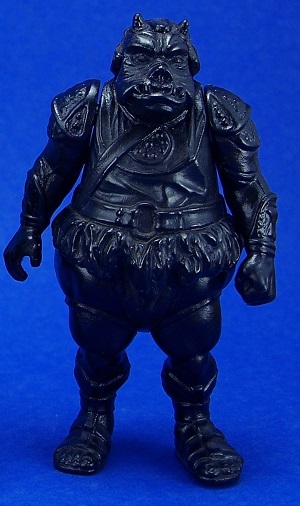
Bench Shot
A Bench Shot is a figure that was injection molded at the shop where the mold was being made and predates those figures that are molded at the production factory. In the vintage days the molds were made in the U.S. while produciton was run overseas in countries or regions like China, Macau, Mexico, and Hong Kong.
Whenever a mold is being made and/or worked on they say it's "on the bench" meaning the workbench in the shop, hence the term. It means that it was "shot" (industry slang for injection molded) on the bench, but not literally on the bench. It would have been made at the same facility although the molding machines wouldn't be too far away from the area where the molds were being built.
It is extremely difficult to know for sure that a figure is a bench shot by appearances alone and so far only a couple of these black Gamorrean Guards have surfaced that seem to fully meet this description. The source of the first one dates back to 2000 and and came from the son of an engraver that worked in an feelance mold shop outside of Ohio where the mold was made. The second example came from an ex-Kenner designer that worked on the entirety of Star Wars line and it appears to be from the very same run. In the first case, the figure never made it far from where it was created, but the designer would have obtained it once samples were sent back to Kenner.
Provenance plays a crucial role in determining if a piece is a bench shot although in the case of this figure, the material and construction is also an indication. The plastic isn't just black, it appears to be polypropylene (like a Rubbermaid food container) and that plastic is used for all parts of the figure. In contrast, a production figure is made with an ABS (Acrylonitrile Butadiene Styrene) torso which is a rigid and hard plastic that keeps its shape well and PVC (Polyvinyl Chloride) limbs and head which are flexible. That's why the limbs were more fun for kids to chew on than the torso was. The differnce was necessary because the flexible limbs were safer and durable for play and the hard torso was better suited to keep the figure feeling fairly solid overall.
Because the ultimate intention is to produce parts from 2 different kinds of plastic, the molds are split up so that you would have at least 2, one mold that made say 4 torso halves (fronts and backs) and another mold that made 8 arms and legs so that in the end you could produce two complete figures during one molding cycle of each. The heads were often done as a third mold because those parts were smaller and took less plastic to fill. When you are molding you want the parts to be fairly equal so that the mold fills evenly. Although in the case of the Gamorean Guard since the legs are so much larger than the arms these may have been further split into yet a fourth mold.
The use of a single plastic makes perfect sense because the mold shop is only concerned with checking the functionality of the molds so they would not bother trying to use the correct plastic and certainly not bother switching the plastic out when they ran the torso molds versus when they ran the molds with the appendages.
Because the process was not always done the same from shop to shop or even from series to series (SW, ESB, etc...) we find things done in different sequences, even between two otherwise identical figures such as these Gamorrean Guards. In both instances the copyright dates were engraved but the foot holes are in place only on one figure. Given that there are no indications of holes or plugs at all on the feet of the first, it was undoubtedly created first. However, because the foot holes on the 2nd piece are molded that means that the mold underwent some major changes. This would require drilling the leg cavities and fitting the retractable pin mechansim. The foot holes in a figure are created with an additional movement as part of the molding cycle. Sometimes it can be a small electric motor, hydraulic cylinder, or even an air cylinder, but it's simply a mechanism to move small pins in and out of the mold. Those pins make the holes in the feet as plasic fills around them.
In many cases we find First Shots that were made in the production factory that did not yet have the copyright dates and/or foot holes. These could very well be bench shots because the molds were not 100% finalized, but sometimes things are not clear cut and we find things molded stateside that look exactly like those parts made overseas. That is why provenance is key and why it is often safer to use the general "first shot" term on this type of piece rather than the more specific "bench shot" as the big difference is just location of manufacture.
Gamorrean Guard Bench Shot (without foot holes)
Gamorrean Guard Bench Shot (with foot holes)
Description: Chris Georgoulias